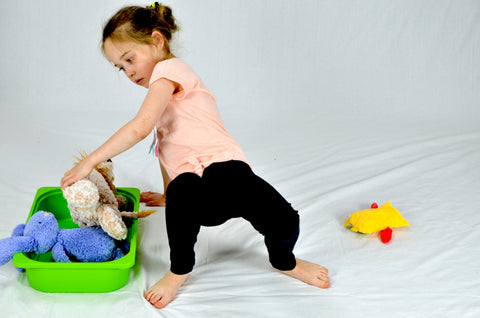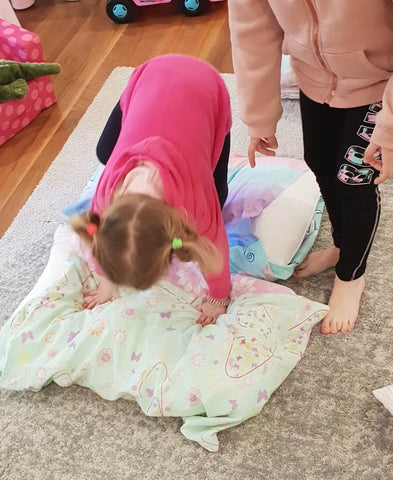
Why obstacle courses need to be included in early childhood planning
Share
My son Hugh used to love playing with blocks, puzzles, and sedentary table top activities when he was in kindergarten. However, Hugh often avoided climbing frames, swings, slides, and balancing across rocks or balance beams as he lacked the confidence in his motor skills.
This is why I am passionate about inspiring educators and teachers to include indoor and outdoor obstacle courses as part of their daily routines, transitions, and play space design.
Join our free online community here to access the obstacle course guide (PDF).
Obstacle courses are important for children's learning and development as they provide a variety of benefits.
Obstacle courses promote:
🌟 physical activity, which is essential for physical development and overall health
🌟 gross motor skill development, children can develop their balance, coordination, core strength, head movement, shoulder stabilisation
🌟 problem-solving and decision-making skills, as they navigate through the obstacles, which helps to develop their cognitive abilities.
🌟 spatial awareness and perception, as children judge distances and angles to navigate through each obstacle
🌟 social and emotional development, obstacle courses encourage teamwork, communication, and cooperation as children may need to wait and work together
🌟 motivation and engagement as children enjoy the challenge and excitement of navigating through each obstacle, which increases their motivation and engagement in the learning process.
Creating an obstacle course for early childhood education that incorporates the benefits you mentioned is a fantastic idea. Here are some must-haves for an obstacle course designed for young children:
-
Safety First: Ensure the entire obstacle course is safe for children. Use soft, non-slip materials for flooring, avoid sharp edges or objects, and secure any loose items. Always supervise the children during the activity.
-
Age-Appropriate Obstacles: Consider the age and developmental stage of the children. Make sure the obstacles are suitable for their size, strength, and abilities. Adjust the difficulty level accordingly.
-
Variety of Obstacles: Include a variety of obstacles that challenge different aspects of physical and cognitive development. For example:
- Balance beams or stepping stones for balance and coordination.
- Tunnels for spatial awareness and perception.
- Hurdles for gross motor skills.
- Puzzles or shape-sorting obstacles for problem-solving skills.
- Low walls or barriers for climbing and upper body strength.
- Tires or hoops for jumping and hopping activities.
-
Clear Instructions: Provide simple and clear instructions for each obstacle. Use visual cues, such as pictures or symbols, to help non-readers understand what to do.
-
Teamwork Opportunities: Design some obstacles that require teamwork and cooperation. This can be achieved through activities like tandem balancing or group challenges where children must work together to complete a task.
-
Adaptability: Make sure the obstacle course can be adapted or modified to suit different skill levels or abilities. This allows all children to participate and experience success.
-
Progression: Create a sense of progression within the course. Start with easier obstacles and gradually increase the difficulty as children advance. This keeps them motivated and engaged.
-
Positive Reinforcement: Encourage and praise children for their efforts and accomplishments as they navigate through the obstacle course. Positive reinforcement enhances motivation and engagement.
-
Reflect and Adapt: After each session, reflect on what worked well and what could be improved. Be open to adapting the course based on children's feedback and needs.
Remember that the key is to create a fun and educational experience that aligns with the developmental goals you've outlined while prioritizing safety and enjoyment for the children.
Here are 10 obstacle course activities that can be adapted for both outdoor and indoor settings, making them suitable for rainy days:
-
Hopscotch Challenge: Create a hopscotch course indoors using tape or markers on the floor. Add variations like hopping on one foot or hopping while holding a stuffed animal.
-
Couch Cushion Course: Indoors, arrange couch cushions or pillows on the floor to create a soft obstacle course. Children can crawl, jump, and balance on them.
-
Indoor Tunnel Crawl: Set up a tunnel made of blankets or large cardboard boxes in a hallway. Children can crawl through it to enhance their spatial awareness and motor skills.
-
Balloon Balance: Place balloons on the floor, and kids must navigate through the room without touching or popping them. This improves balance and coordination.
-
Indoor Hurdles: Use sturdy objects like empty cardboard boxes or stuffed animals as hurdles. Children can jump or step over them.
-
Lava Floor: Pretend the floor is lava, and use cushions, rugs, or pieces of paper as stepping stones to cross the "hot" floor without touching it.
-
Obstacle Course Relay: Create a series of challenges like crawling under a table, jumping over a line, or spinning in a circle. Children can take turns completing the course, making it a friendly competition.
-
Indoor Bowling Alley: Set up a bowling alley with empty plastic bottles as pins and a soft ball as the bowling ball. Children take turns rolling the ball to knock down the pins.
-
Sofa Bridge: Place a sturdy board or a large piece of cardboard between two couches to create a bridge. Children can practice walking or crawling across it.
-
Indoor Crawling Maze: Use furniture, cushions, and toys to create a crawling maze with different pathways and obstacles. Children must navigate through the maze to reach the other side.
For all indoor obstacle course activities, ensure that the environment is safe and free from hazards. Clear away any sharp objects or items that might cause tripping. Additionally, always supervise children during these activities to ensure their safety.

